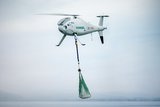Northrop Grumman tests new sensor for BAMS applications
Northrop Grumman Corporation has announced the start of system tests of a new Multi-Function Active Sensor (MFAS) being developed here for use by the US Navy onboard the MQ-4C Broad Area Maritime Surveillance Unmanned Aircraft System (BAMS UAS).
The MFAS is a 360-degree field-of-regard active electronically scanned array radar designed for maritime surveillance. The X-Band two-dimensional sensor features a combination of electronic scanning and a mechanical rotation, allowing the radar to spotlight a geographic area of interest for longer periods to increase detection capabilities of smaller targets, particularly in sea clutter.
"BAMS will provide the Navy with a very capable persistent maritime intelligence, surveillance and reconnaissance system to provide a capability to detect, track, classify, and identify maritime and littoral targets," said Capt. Bob Dishman, the Navy's BAMS UAS program manager.
"With our successful Critical Design Review behind us and sensor testing underway, our customer-industry team is rapidly pulling the components together that will result in first MQ-4C flight next year," said Steve Enewold, Northrop Grumman vice president for the BAMS program.
The MFAS tests are being conducted in a laboratory environment at Northrop Grumman and are expected to continue over the next several months in parallel with ongoing radar software mode development and hardware synchronization and integration activities.
The first MFAS sensor is scheduled for delivery to Northrop Grumman's Aerospace Systems sector facility in San Diego, Calif., in June with a second sensor slated for delivery in September. Risk reduction flight tests of the MFAS are planned for later this year onboard the company's Gulfstream II test-bed aircraft.
"This is a very significant first step toward providing the US Navy warfighter with a new and powerful ISR capability," said Paul "Buz" Kalafos, vice president of Surveillance Systems at Northrop Grumman's Electronic Systems sector.
The Northrop Grumman MQ-4C BAMS UAS is a versatile maritime intelligence, surveillance and reconnaissance aircraft system that will perform maritime missions independently or in direct collaboration with fleet assets. BAMS UAS will play a key role in providing fleet commanders with a persistent, reliable picture of maritime surface contacts, covering vast areas of open ocean and littoral regions in a highly efficient manner.
The BAMS UAS program is managed by the Navy's Program Executive Office, Unmanned Aviation and Strike Weapons' Persistent Maritime Unmanned Aircraft Systems Program Office (PMA-262), located at Naval Air Station Patuxent River, Md.
The BAMS UAS is the latest addition to a growing family of unmanned systems developed by Northrop Grumman. The BAMS UAS system builds on the company's more than 60 years experience with unmanned aircraft and autonomous flight control, including thousands of flight hours by the combat-proven RQ-4 Global Hawk, the MQ-8B Fire Scout vertical takeoff and landing tactical unmanned aerial system (VTUAV)-the first completely autonomous VTUAV aircraft to land aboard a Navy vessel underway-and the X-47B Unmanned Combat Air System-the first unmanned air vehicle scheduled to perform carrier landings.
Source: Northrop Grumman
More from Uncrewed Vehicles
-
Jammer resistant drone designs spark search for countermeasures
The Russia-Ukraine conflict has driven another stage of evolution for drones and the counter measures to defend against them.
-
![L3Harris launches Amorphous software for control of uncrewed platforms]()
L3Harris launches Amorphous software for control of uncrewed platforms
The new Amorphous software is a universal controller that would allow a single operator to control a swarm of “thousands” of uncrewed systems, from drones to underwater platforms.
-
ideaForge unveils new UAVs at Aero India 2025
India UAV supplier ideaForge has launched the Netra 5 and Switch V2 drones at Aero India 2025, boasting of enhanced endurance, AI-driven autonomy and improved operational capabilities.
-
![Shaping the future of defence: What 2025 holds for the global drone market]()
Shaping the future of defence: What 2025 holds for the global drone market
The UAV market is experiencing unprecedented growth, with innovations in technology and battlefield applications driving demand across military sectors. From the battlefields of Ukraine to NATO exercises and beyond, drones are transforming how wars are fought and supported.
-
![Maris-Tech confirms customers signing up for Jupiter Drones codec and AI-powered system]()
Maris-Tech confirms customers signing up for Jupiter Drones codec and AI-powered system
Launched at AUSA in October, the company’s multi-stream video codec is attempting to bring a new lease of life to drone technology through its AI accelerator.
-
![AUSA 2024: Quantum-Systems targets big 2025 with UAS developments]()
AUSA 2024: Quantum-Systems targets big 2025 with UAS developments
Quantum-Systems has been upgrading its UAS family, with new versions of the Vector, Reliant and Twister drones set for release throughout 2025.
























